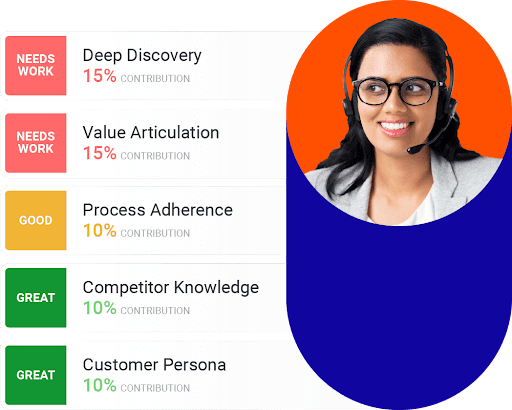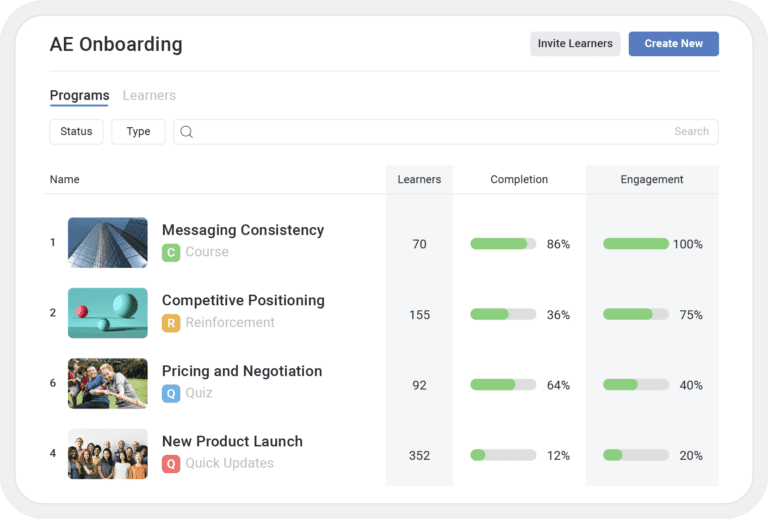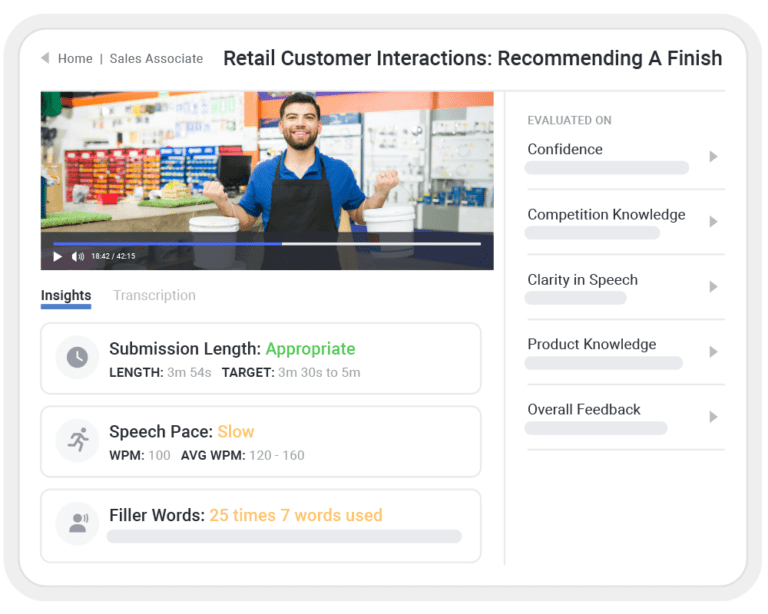Hiring strong sales reps with the right mix of skills and experience is important. But sales training is key to ensuring all sales reps (even your top performers) are properly equipped to close more deals, faster.
In fact, sales training is an essential component of any winning sales enablement strategy. When it’s done well, training can have a big impact on sales outcomes.
But what exactly is it?
In this guide, we’ll explore everything you need to know about sales training, including:
- What it is and why it matters
- How it can benefit your revenue organization
- How you can build and deliver the best program
- Key pitfalls to avoid when building your program
Sales training: What it is and why it matters
First things first, what exactly is sales training?
Sales training ensures your sellers have the knowledge, skills, and competencies they need to be ready for every step of the sales journey – from prospecting to closing the deal.
Going beyond sales onboarding
At most organizations, the training journey starts with onboarding. Sales onboarding is an important way to get new reps up to speed with your organization, products, and goals – as well as their role in achieving those goals. It makes sense why organizations invest in sales onboarding. When it’s effective, onboarding can greatly impact key business outcomes.
But all too often, it ends at onboarding. Per an analysis of Mindtickle users, onboarding took 21-22 days in 2023, compared to 58 days the year prior.
Days it took to onboard sellers
However, sales training shouldn’t stop at onboarding. Why? There are a few important reasons.
For starters, sellers are thrown a lot of information during sales onboarding. Even if you’ve built a great, engaging sales onboarding program, new reps are going to forget some of what they’ve learned. In fact, they’re going to forget most of it. Per Gartner, sellers forget 70% of the information they learn within just one week of training. Ongoing training (what we at Mindtickle refer to as “everboarding”) ensures learning sticks – and that sales reps are actually applying what they’ve learned to drive sales.
In addition, it’s important to remember that change is the only constant – both in life and in sales. Products, markets, competitors, and priorities are constantly changing. All reps – from the newest to the most seasoned – need ongoing training to ensure they’re up to speed on these changes and ready for whatever comes at them in the field.
The key benefits of sales training
There are many benefits of sales training. Here are two of the most important.
1. It positively impacts sales growth
Today, many sales leaders buy into the 80/20 rule, which is the outdated notion that 80% of sales will be driven by 20% of your reps. That means the vast majority of your reps will miss their sales quotas quarter after quarter.
But there’s a way to make sure all your sellers are meeting and beating their quotas.
With a strong program, you can create an entire team of sellers that are equipped to close deals and meet quota. Of course, when more sellers are closing more deals, that’s going to lead to more revenue growth.
2. It improves seller engagement and retention
When a great rep decides to leave, it’s costly to your company. For starters, you’re losing revenue the rep would have generated. Plus, you have to factor in the costs of recruiting, hiring, and training a new rep to replace them. It adds up! In fact, according to research from DePaul University, it costs nearly $115,000 to replace a sales rep.
Either way, the message is clear: when you find great reps, it’s important to do what you can to retain them.
Research tells us you can lose upwards of 60% of your entire workforce within four years if your sales reps don’t feel like they’re learning and growing at your organization. Providing ongoing sales training is a great way to engage your sales reps and give them opportunities to learn and grow. This will boost job satisfaction, which will increase retention. Higher retention will save you the headache and costs of filling vacant roles – or the pressure of meeting your sales goals with a leaner team.
Six tips for more effective sales training
The potential benefits are clear. However, claiming to deliver training isn’t enough to see the benefits. In fact, according to ES Research, between 85% and 90% of training has no lasting impact.
What is it that sets great training apart from the rest?
Here are six tips to improve the effectiveness of your program.
Tip #1: Don’t stop at onboarding
We’ve said it before, but it’s worth repeating: training should extend beyond sales onboarding.
Sellers forget the vast majority of what they learned during onboarding. What’s more, products, markets, and selling landscapes are constantly changing and evolving.
Ongoing training is a key component to ensuring all of your reps are ready to sell. Training should be delivered regularly for maximum impact. According to a Heinz Marketing and Mindtickle report, among respondents who hit 75% or more of their quota, 90% participate in monthly training.
Tip #2: Define excellence
Sales training aims to create more, great sellers. But first, you have to determine what a great seller looks like.
Chances are, you have an ideal customer profile (ICP), which outlines what a good fit customer looks like for your business. But it’s just as important to define your ideal rep profile (IRP), which is the skills and competencies a seller needs to succeed in your organization.

Then, you can plan courses and programs that map to each key area. That way, you can be sure your training is helping sellers boost the skills and competencies they need.
Tip #3: Make it personal
Imagine you have two sellers in the same room. One is a veteran seller, and has been with your company for a few years. The other is a recent college grad with big potential – but only a year of sales experience. Does delivering the same training to those two sales reps make sense?
Absolutely not. The newer seller likely needs more training on being a great seller. But if you deliver that same training to the veteran seller, they’ll get bored and disengaged.

Of course, there will be certain training all sellers need to complete. But as a general rule, it shouldn’t be one-size-fits-all. Instead, sales leaders must work to understand the strengths and weaknesses of each seller. The best way to do this is to measure each rep against your ideal rep profile. By doing so, you’ll see where they’re shining and where there are gaps. Then, personalized training can be delivered to each rep to close gaps – and improve sales performance.
Tip #4: Reinforce training
It’s disappointing, but it’s true: sellers will quickly forget what they learned in training. If you want that learning to stick (who doesn’t?), you’ve got to reinforce it.
Be sure to incorporate reinforcement exercises into your strategy. For example, after a training session, assign your sellers a quiz. If they earn a low score, assign them bite-sized video modules reinforcing the concepts presented during the training session.
It’s a best practice to house all materials within a single sales training platform. That way, reps have a one-stop-shop for everything they need.
Tip #5: Mix up the format
The phrase “sales training” might conjure images of an instructor standing at the front of a room filled with sales reps. Sure, real-time training sessions – in-person or via video – are an important part of it. However, it also makes sense to incorporate other types of training.
For example, you might assign bite–sized training modules for sales reps to complete on their own time. You might also assign a quiz to test knowledge. Another idea is to assign role-plays to allow reps to practice their new skills and get feedback from either their manager or peers (or both).

Again, it’s important to ensure all training material is housed within a single platform so reps can easily find what they need.
Tip #6: Measure the impact
You can’t improve what you don’t measure. And without regular measurement, it’s impossible to determine what (if any) impact your training has on reps’ performance.
Many organizations measure completion rates. While this is important, it doesn’t tell the whole story. A seller may fly through their assigned training but fail to perform when interacting with buyers.
As such, it’s key to measure how your training impacts key business outcomes, such as quota attainment and win rates. In addition, be sure to continuously measure your reps against your ideal rep profile. That way, you can understand how training is positively impacting skills and in-field behaviors.
Sales training vs. sales coaching: What is the difference?
Training and coaching are key components of a sales enablement strategy. Often, these phrases are used interchangeably. Training and coaching are two pieces of the same puzzle, but they’re not the same.
At each organization, there are a certain set of skills and competencies a seller needs to be successful throughout the sales cycle. Training is focused on delivering knowledge to help reps learn those skills and competencies. Classes and modules can be focused on any number of things, including (but not limited to):
- Product knowledge
- Sales methodology
- Ideal customer profiles
- Pitch delivery
- Objection handling
- Use of tools, including CRM
Sales coaching is aimed at improving sales performance. However, the delivery methods and tactics are different. The goal of sales coaching is to improve sales performance through strategies including:
- Relationship-building
- Knowing and analyzing what’s happening in the field
- Delivering individualized plans to improve deal outcomes and build key skills for each sales rep
When it’s done well, sales coaching can extend the impact of training and have a big impact on sales results. In fact, effective sales coaching can boost win rates by as much as 29%.
What exactly does sales coaching look like?
The most effective managers work closely with each sales rep to understand their unique strengths and weaknesses. In addition, they leverage meeting intelligence to see firsthand how reps are performing in the field. Armed with these insights, sales managers can deliver sales coaching that helps reps capitalize on strengths and improve weaker skills and competencies.
Often, sales coaching is limited to deal coaching. In other words, a rep and manager regularly review in-flight deals and determine how to move them forward. However, it’s also important to provide skills coaching. Skill coaching drives long-term behavior change and helps reps hone the skills they need to close deals.
Training and coaching shouldn’t be viewed as an either/or choice. Instead, both are key to ensuring reps are ready to move deals through the funnel and eventually close them.
Sales training mistakes to avoid
Many organizations invest time and resources into developing sales training programs. However, the harsh reality is that these programs often fail.
If you’re looking to increase the effectiveness of training at your organization, be sure to avoid these four common sales training mistakes.
Mistake #1: Taking a “one and done” approach
It’s not realistic to deliver training one time and expect the entire team to retain what they learned and apply it in the field. Instead, it’s important to deliver training on an ongoing basis and provide reinforcement exercises and practice opportunities.
Average companies
Winning companies
Role-plays are one popular way to allow sales reps to practice their new skills, and they’re correlated with sales success. A recent analysis found that the average company has sellers complete 13 role-plays in a year. However, top companies have sellers do an average of 80 role-plays per year.
Mistake #2: Requiring every seller to complete every training
It’s not effective to create a generic sales training that requires every member of the revenue team to complete. If a sales training is focused on a skill a seller has already mastered, they’ll be disengaged. Plus, they’ll be wasting time that could be better spent engaging with buyers and closing deals.
Instead, measure each sellers’ mastery of the skills and behaviors that matter most. Then, assign relevant training that helps each seller strengthen their weaker skills.
Mistake #3: Only measuring success with completion metrics
Ongoing measurement is a key component of any sales training program. However, many organizations focus on completion metrics. In other words, they measure what percentage of sales reps complete a specific training.
Revenue organizations must go beyond completion metrics to understand the actual impact. Be sure to track sales training completion and how it is (or isn’t) impacting sales productivity.
Mistake #4: Depending on an outdated LMS to power your sales training program
A learning management system (LMS) can be a great solution for more general training, such as that that HR and IT teams deliver. However, an LMS isn’t built for the unique needs of the sales team.
A better approach is to invest in an integrated revenue enablement solution that incorporates all the key elements of revenue enablement, including sales training, sales coaching, sales content, and conversation intelligence. That way, sellers can access everything they need in one location. This is great news, as Salesforce research found that 66% of sales reps are overwhelmed with the number of tools they’re expected to use.
Salesforce research found that
Furthermore, an integrated revenue enablement platform allows enablement teams to create and deploy personalized programs that meet the needs of every seller – at scale. Enablement teams can also holistically measure the impact of all their initiatives on sales productivity and performance.
Supercharge your sales training program with Mindtickle’s integrated revenue enablement platform
Hiring experienced sellers is one piece of the puzzle. But even the most seasoned sales reps need ongoing training to ensure they’re ready to conquer any deal.
Generic sales training simply won’t do. Instead, revenue enablement teams must work to define what excellence looks like – and then deliver personalized sales training and sales enablement to ensure every seller has what it takes to succeed.
Today, some revenue organizations continue to leverage a learning management system (LMS) to deliver sales training. However, a growing portion are trading in their LMS for an integrated revenue enablement platform.
With an integrated revenue enablement platform like Mindtickle, revenue organizations can power their entire revenue enablement program – including sales training – all from one central location. That means revenue enablement leaders can build, deliver, and measure the impact of sales training and sales enablement initiatives – all in one platform. Furthermore, sellers can easily access the sales training, coaching, content, conversation insights, and other information and resources they need to close more deals, faster.
Sales training in Mindtickle
Ready to see why top revenue organizations are trading their LMS for Mindtickle?
Get Your DemoThis post was originally published in November 2022 and updated in July 2024.



 By Helen Waite
By Helen Waite
 By Poornima Mohandas
By Poornima Mohandas
 By Rahul Mathew
By Rahul Mathew